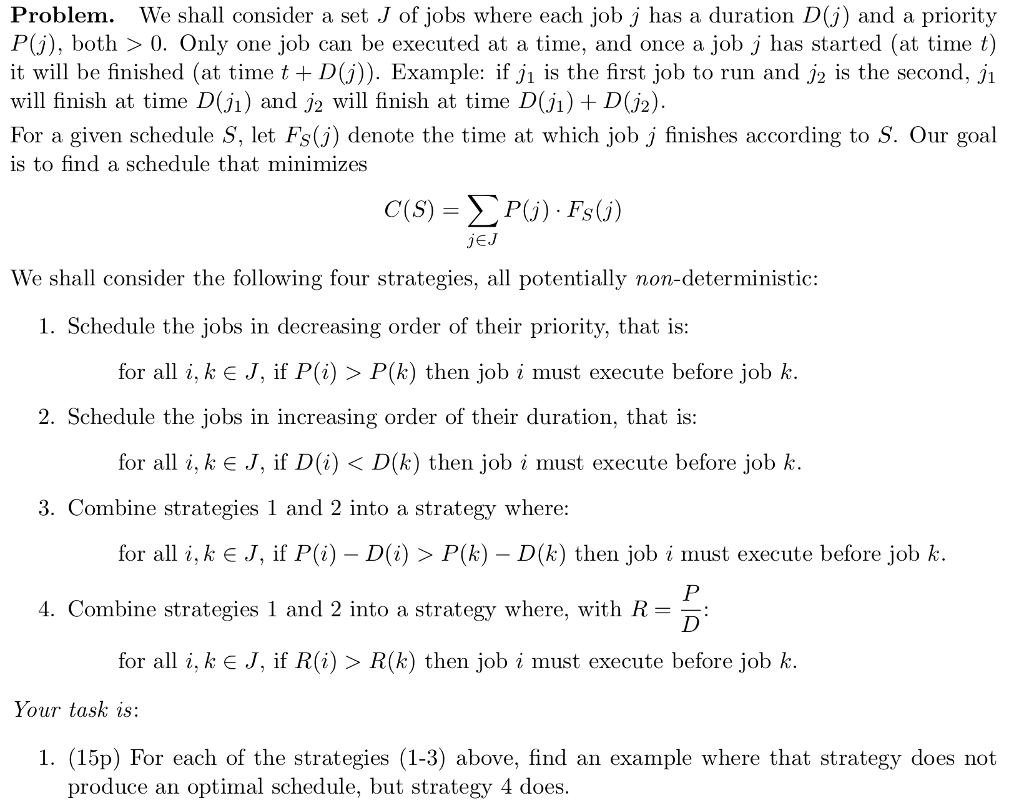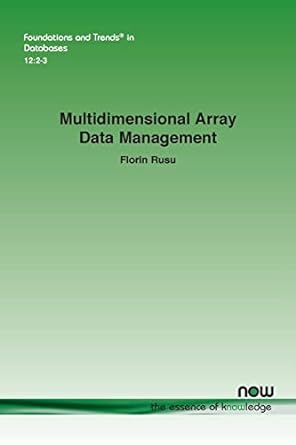Question
Text: Problem. We shall consider a set J of jobs where each job j has a duration D(j) and a priorityP(j), both > 0. Only

Text:
Problem. We shall consider a set J of jobs where each job j has a duration D(j) and a priorityP(j), both > 0. Only one job can be executed at a time, and once a job j has started (at time t) it will be finished (at time t + D(j)). Example: if j1 is the first job to run and j2 is the second, j1will finish at time D(j1) and j2 will finish at time D(j1) + D(j2).
For a given schedule S, let FS(j) denote the time at which job j finishes according to S. Our goal is to find a schedule that minimizes
C (S ) = ?? P (j ) FS (j )j?J
We shall consider the following four strategies, all potentially non-deterministic: 1. Schedule the jobs in decreasing order of their priority, that is:
for all i,k ? J, if P(i) > P(k) then job i must execute before job k. 2. Schedule the jobs in increasing order of their duration, that is:
for all i,k ? J, if D(i)
for all i,k ? J, if P(i)?D(i) > P(k)?D(k) then job i must execute before job k. 4. Combine strategies 1 and 2 into a strategy where, with R = P :
D for all i,k ? J, if R(i) > R(k) then job i must execute before job k.
Your task is:
(15p) For each of the strategies (1-3) above, find an example where that strategy does not
produce an optimal schedule, but strategy 4 does.
Problem. We shall consider a set J of jobs where each job j has a duration D(j) and a priority P(j), both > 0. Only one job can be executed at a time, and once a job j has started (at time t) it will be finished (at time t D(j)). Example: if ji is the first job to run and j2 is the second, j? will finish at time D(i) and j2 will finish at time D(ji) + D (j2) For a given schedule S, let Fs (j) denote the time at which job j finishes according to S. Our goal is to find a schedule that minimizes C(s)- P(j) Fs(j) JE.J We shall consider the following four strategies, all potentially non-deterministic: 1. Schedule the jobs in decreasing order of their priority, that is: for all i, k E J, if P(i) > P(k) then job i must execute before job k. 2. Schedule the jobs in increasing order of their duration, that is: for all i, k E J, if D(i) P(k) - D(k) then job i must execute before job k. 4. Combine strategies 1 and 2 into a strategy where, with R - for all i, k E J, if R(i) > R(k) then job i must execute before job k. Your task 2S. 1. (15p) For each of the strategies (1-3) above, find an example where that strategy does not produce an optimal schedule, but strategy 4 does Problem. We shall consider a set J of jobs where each job j has a duration D(j) and a priority P(j), both > 0. Only one job can be executed at a time, and once a job j has started (at time t) it will be finished (at time t D(j)). Example: if ji is the first job to run and j2 is the second, j? will finish at time D(i) and j2 will finish at time D(ji) + D (j2) For a given schedule S, let Fs (j) denote the time at which job j finishes according to S. Our goal is to find a schedule that minimizes C(s)- P(j) Fs(j) JE.J We shall consider the following four strategies, all potentially non-deterministic: 1. Schedule the jobs in decreasing order of their priority, that is: for all i, k E J, if P(i) > P(k) then job i must execute before job k. 2. Schedule the jobs in increasing order of their duration, that is: for all i, k E J, if D(i) P(k) - D(k) then job i must execute before job k. 4. Combine strategies 1 and 2 into a strategy where, with R - for all i, k E J, if R(i) > R(k) then job i must execute before job k. Your task 2S. 1. (15p) For each of the strategies (1-3) above, find an example where that strategy does not produce an optimal schedule, but strategy 4 doesStep by Step Solution
There are 3 Steps involved in it
Step: 1

Get Instant Access to Expert-Tailored Solutions
See step-by-step solutions with expert insights and AI powered tools for academic success
Step: 2

Step: 3

Ace Your Homework with AI
Get the answers you need in no time with our AI-driven, step-by-step assistance
Get Started


